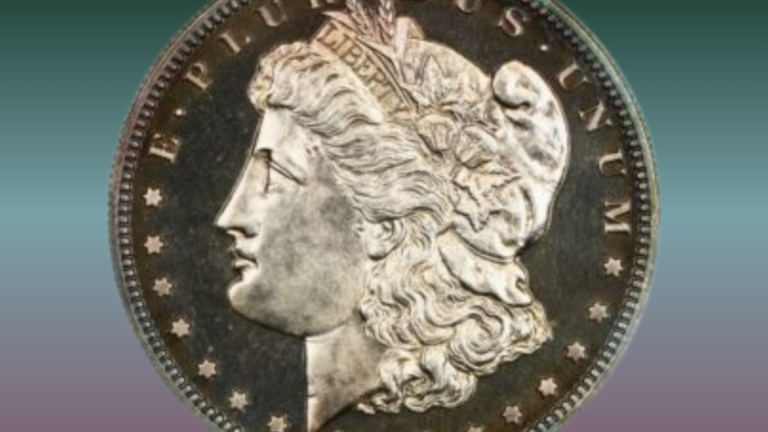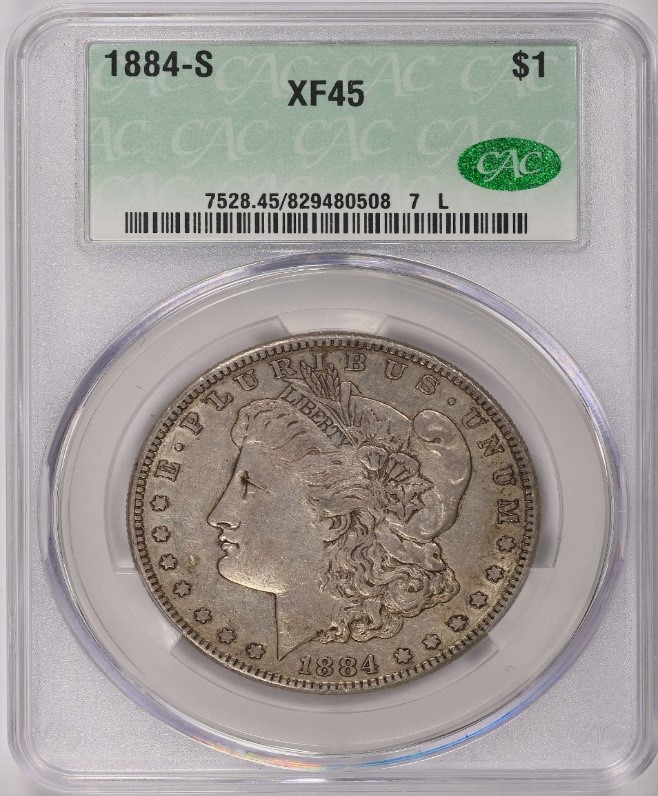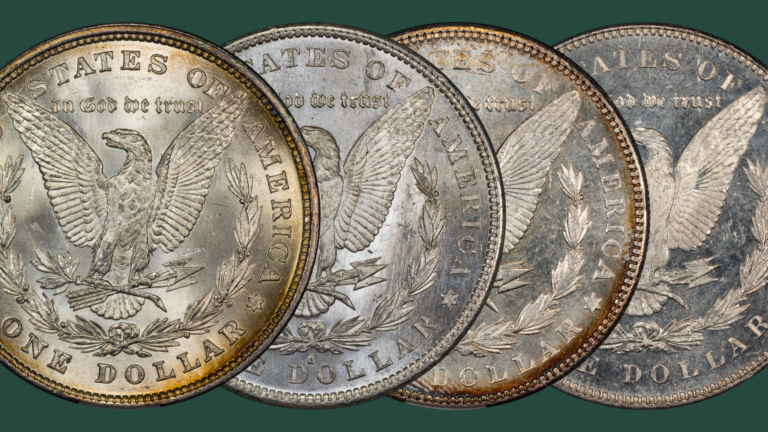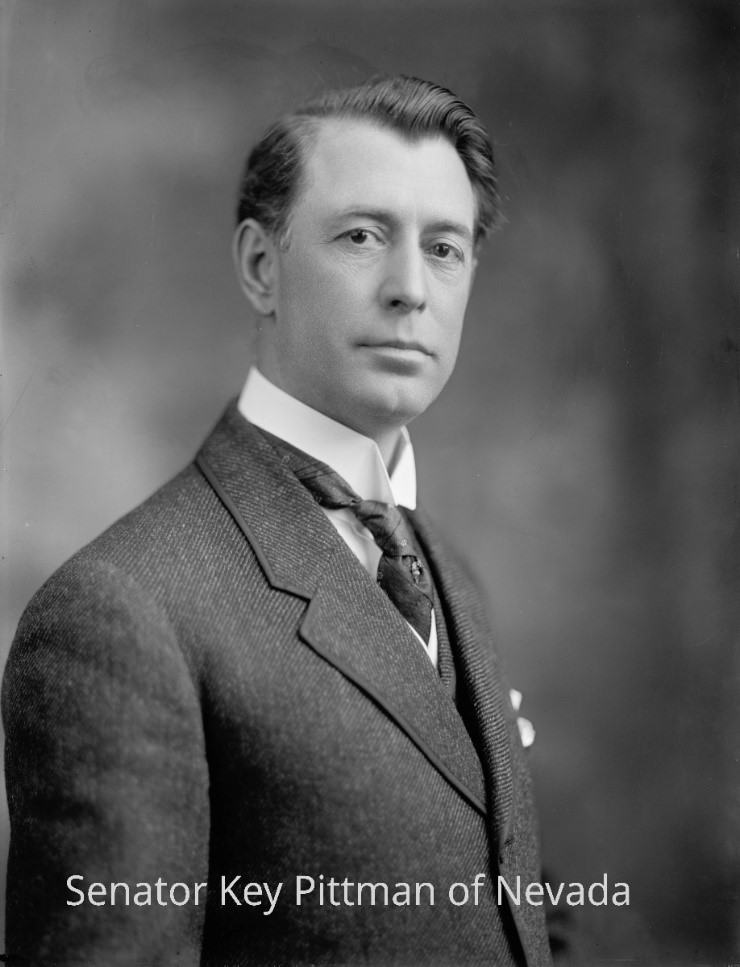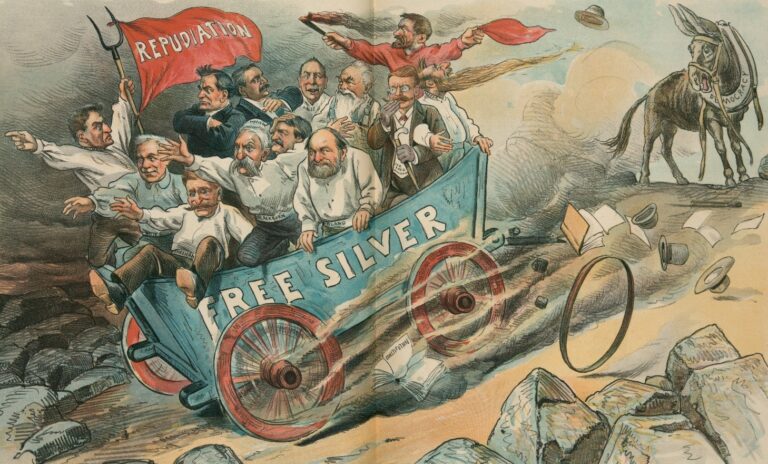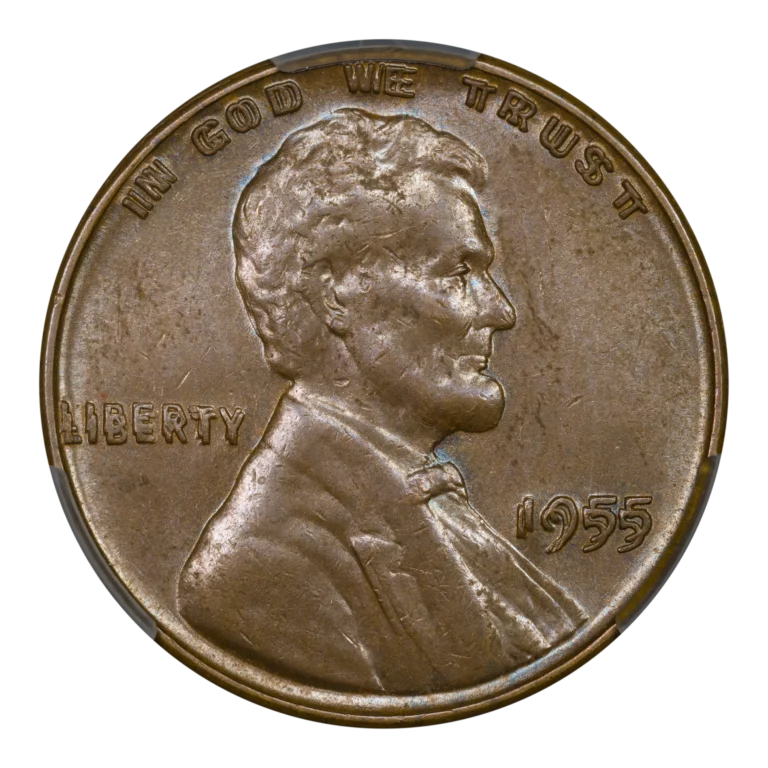by Greg Reynolds
This discussion follows that about assembling a later type set of Proof, classic U.S. half dollars, those that were minted after the U.S. Civil War (1861-65). Earlier Proofs tend to be more expensive, much rarer and more intriguing than post-1865 Proof half dollars. Indeed, most coin collectors have never seen a Proof half dollar that was minted before 1861.
It is best for collectors to begin with the later issues and ‘travel backwards in time.’ Such a journey relates to the history of the U.S. Mint, the history of coin collecting and the monetary history of the nation. For those who are enthusiastic about Proof silver coins or become increasingly interested while pursuing them, it is very exciting to build a type set of Proof half dollars.
Type #9 – Liberty Seated, No Motto, With Arrows, No Rays (1854-55)
PCGS and NGC reports include some multiple counts of individual coins, and it is not clear that every 1854 or 1855 half that is certified as a Proof is a true Proof. Tentatively, I suggest that between twenty-two and thirty Proofs of this type survive. CAC reports having approved thirteen.
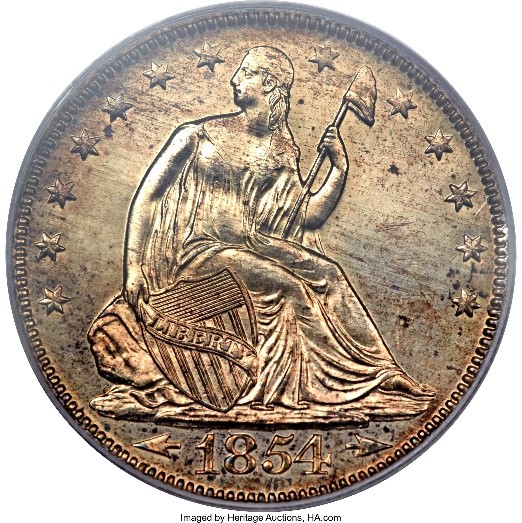
On Nov. 5, 2013, Heritage auctioned a CAC approved, NGC certified Proof-66 1854 half from the Eric Newman Collection, for $49,937.50. I enjoyed examining this coin. This coin’s texture is interesting and its natural tones are neat. I estimate that this coin’s current medium-retail value is less than the price realized in 2013.
In August 2018, Heritage auctioned a CAC approved, PCGS certified Proof-64-Cameo 1855 that was earlier in the collection of the late Gene Gardner, a legend in the realm of investment fund management. This Proof 1855 half dollar realized $22,800 in August 2018 and $23,500 in October 2015 in the Gardner IV auction.
The Gardner 1855 was moderately dipped long ago and has naturally retoned nicely. Dynamic mirrors capture the attention of any coin enthusiast who sees this 1855 half. In addition, there is much russet and blue-gray toning. Certainly, this coin is appealing and memorable.
In June 2014, for $30,550, Heritage auctioned a CAC approved, PCGS certified Proof-64 1855/4 overdate half dollar that was also from the Gene Gardner Collection. The mirrored fields on this 1855/4 are very much complete and are lively. Furthermore, the natural toning is appealing. This is a very entertaining coin.
In 2019, Witter Coins offered a CAC approved, PCGS certified Proof-65 1855/4 half for $85,000. This same coin was auctioned by Bowers & Merena in November 1988 as part of the Norweb Collection and was later in a pre-ANA auction conducted by Superior Galleries in 1993. In April 2015, Heritage auctioned this CAC approved Proof-65 1855/4 for $76,375.
For Proof 1854, 1855/4 and 1855 ‘With Arrows’ half dollars, 63 and 64 grade coins tend to cost much less than gems. CAC has approved five of this type as Proof-65, three as Proof-64, three as Proof-64-Cameo and one as Proof-63. There is a very good chance that at least one CAC approved Proof of this type will be available in the near future for a price in the range of $18,000 to $41,000.
Type #8 – Liberty Seated, Arrows & Rays (1853 only)
Proof 1853 ‘Arrows & Rays’ halves are characterized by a fabric and a finish that are markedly distinct from other Proof Liberty Seated half dollars, even much different from Proof 1854 and 1855 halves. All the physical characteristics of these cannot be explained. Rather than deep mirrors, these have oddly glittering, reflective surfaces with die finishing lines that become vibrant when the coin is tilted and reflect light in a curiously entertaining manner.
Many die finishing lines on these were imparted on the dies in a deliberate and fascinating pattern. The die finishing lines themselves appear to be a noteworthy work of art. Unfortunately, though, the die finishing lines tend to not be apparent in photographs or online images. Even more so than most 19th century coins, Proof 1853 halves must be tilted under a lamp, and viewed with a magnifying glass, to really be understood and appreciated.
Despite not having traditional thick mirrored fields, Proof 1853 halves are extremely reflective. Moreover, Proof 1853 halves are characterized by well detailed design elements, broad rims and significant squaring of outer devices. In ways that are impossible to fully explain, they are wonderfully special; they are just different from silver coins of the mid-19th century that are clearly Proofs. Certainly, CAC approved Proof 1853 ‘Arrows & Rays’ halves are accepted among well financed dealers as Proofs or as very special strikings that may fairly be called Proofs. They are obviously not business strikes. Collectors of pre-1866 Proof half dollars usually feel compelled to strive for one.
CAC has approved one 1853 half as Proof-63, one as Proof-64 and one as Proof-65. In October 2014, Stack’s-Bowers auctioned a CAC approved, PCGS certified Proof-64 1853 ‘Arrows & Rays’ half dollar for $94,000. This coin was earlier in the epic type set formed by former Congressman Jimmy Hayes, a veteran numismatist who has been attending major coin conventions for decades. I chatted with him at the ANA Convention in Rosemont, Illinois, during August 2021. We discussed the U.S. type set in The Tyrant Collection, which was then on display. In October 1985, Stack’s (NY) auctioned Hayes’ epic type set of copper, nickel, and silver U.S. coins.
The Hayes 1853 half dollar is incredibly cool, with fascinating patterns of die finishing lines and a reverse that beams in an indescribable manner. U.S. Mint personnel must have enjoyed preparing the dies and striking this coin.
The CAC approved, PCGS certified Proof-65, Parmelee-Newcomer 1853 was auctioned by Heritage in January 2012 for $184,000 and in August 2018 for $228,000. While I like this coin, I was more enthusiastic about the Hayes 1853, which might be a better price value than the Parmelee-Newcomer 1853. On Oct. 18, 2021, the CPG-CAC retail price estimate for the Hayes coin was “$96,600.”
Cataloguers for Heritage list five certified Proof 1853 halves plus a raw Proof 1853 half in the Smithsonian, for a total of six, along with some entries from auction catalogues in the past that may possibly refer to additional Proof 1853 halves. PCGS lists five and NGC lists three, for a total of eight, which does not include the Smithsonian Collection 1853.
I believe that at least six different 1853 halves have been catalogued as Proofs in major auctions during the last fifty years, though it does not necessarily follow that they are all Proofs. I have never seen the pertinent 1853 half in the Smithsonian. As there are such a small number that are potentially available to collectors, it is probably a good idea to carefully consider each one that becomes available.

Type #7 – Liberty Seated, With Drapery, No Motto (1839-53, 1856-66)
It is easy to find and purchase a ‘No Motto’ Proof. Those dated after 1857 tend to be relatively inexpensive. Earlier Proofs of this type are much rarer.
On January 21, 2021, Heritage auctioned a PCGS certified Proof-64+ 1859 half, with a CAC sticker, for $2640. On January 4, 2017, Heritage auctioned the same coin in the same holder for $3055. In November 2021, a fair retail price for this coin might be around $3200.
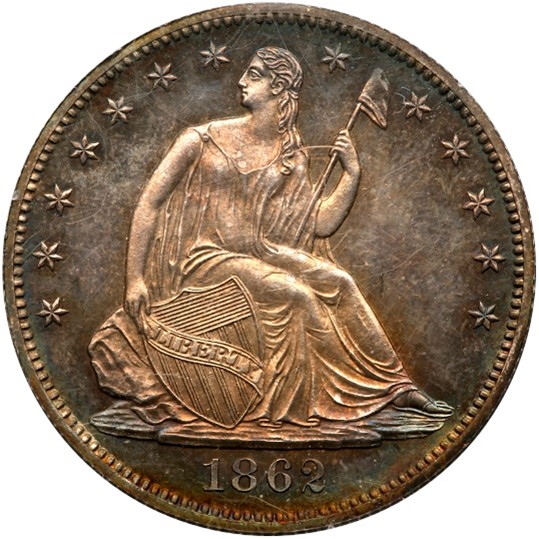
On February 1, the Goldbergs auctioned a CAC approved, PCGS certified Proof-64 1862 half for $2340. On January 21, 2021, Heritage auctioned a CAC approved, PCGS certified Proof-65 1862 half for $4320.
On June 11, 2021, Stack’s-Bowers auctioned a CAC approved, PCGS certified Proof-65-Cameo 1863 half for $5280. On June 27, GreatCollections sold a CAC approved, NGC certified Proof-65-Cameo 1864 half for $7604.30.
Market levels for Proof ‘No Motto’ Liberty Seated halves increased during the first eight months of 2021. Even so, a CAC approved Proof-65 coin of one of the least scarce dates should retail for less than $5000 during late 2021 or early 2022, maybe even for less than $4600.
CAC approved Proof-64 halves are considerably less expensive than CAC approved Proof-65 ‘No Motto’ half dollars. Those that grade 66 and higher are condition rarities, and an expert should be consulted before acquiring a Proof-66 ‘No Motto’ half. Also, I recommend against paying a large premium for a Proof coin with a ‘Cameo’ contrast, though I realize that some collectors strongly prefer them.
On the whole, many Proof half dollars dating from 1858 to 1864 survive, and each buyer may select a coin that he or she really likes. It is common for these to have natural blue, tan and brown-russet toning, sometimes with apricot tints.
Type #6 – Liberty Seated, No Drapery, No Motto (1839 only)
It is generally believed that about seven of these are known, though more research is needed in regard to the pedigrees and precise physical characteristics of each. I have been carefully examining such coins for decades in auction settings and at major conventions. I am not convinced that there exist as many as seven different 1839 ‘No Drapery’ halves that are Proofs or non-Proof Special Strikings.
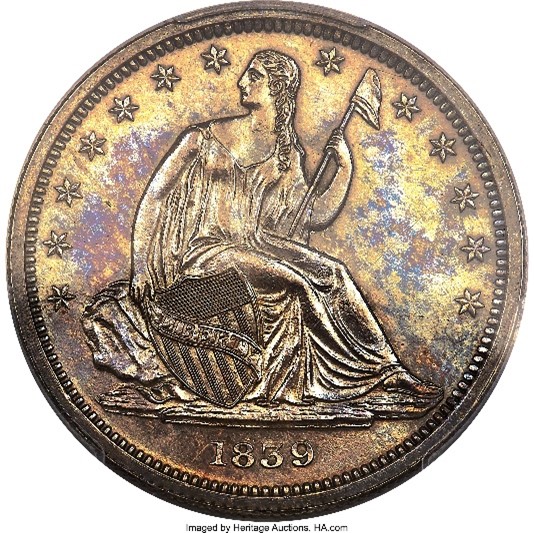
While CAC has only approved one 1839 ‘No Drapery’ half as a Proof, a 64-grade coin, I suggest that three of the other PCGS or NGC certified coins, which I have seen, would be regarded as Proofs by experts at CAC, though have not passed or would not pass at CAC for other reasons.
Certified ‘Proof’ 1839 ‘No Drapery’ Liberty Seated halves do not feature the strong Proof characteristics of Liberty Seated half dollars from the mid to late 1840s or from the 1860s. They are distinctive in other ways. I have examined a few 1839 ‘No Drapery’ halves that exhibit much squaring of design elements, fully reflective fields, and relatively broad rims, plus aspects of their dentils and numerals distinguish them from business strikes.
The lone CAC approved coin was PCGS certified as Proof-64+ before it was auctioned for $223,500 on Nov. 1, 2013. This coin exhibits very appealing natural colors.
It should not be assumed that the only CAC approved Proof of this design type will become available for a reasonable price in the near future. If a collector decides to pursue one of these for a type set, then it may be best to seek one of the 1839 ‘No Drapery’ halves that have been certified as Proof-62 or Proof-63, consulting an expert to make sure that a chosen coin has persuasive Proof characteristics, and paying a non-CAC price for it, hopefully a price that is commensurate with the true quality of the respective coin.
Type #5 – Gobrecht Capped Bust, ‘Reeded Edge’ (1836-39)
I apologize for boring some collectors by repeating my point that the two types of Capped Bust halves are very different. It is true that each coin of the later type (1836-39) has a reeded edge and coins of the earlier Capped Bust type (1807-36) have letters and symbols on their edges. Even so, other differences are much more noticeable and more important than the edges.
Regarding the distinctions between the two types of Capped Bust half dollars, please see my other guides that cover half dollars from the 1830s. Coins of the ‘reeded edge’ type should be called Gobrecht Capped Bust halves and coins of the ‘lettered edge’ type (1807-36) should be called Reich Capped Bust halves.
It used to be true that a collector seeking a Proof of this type would focus on 1838 and 1839 Philadelphia Mint coins, as their business strike counterparts are not scarce. Proof 1836 halves, however, are among the least costly of Proof Gobrecht Reeded Edge halves, although business strike 1836 halves of this type are very scarce.
CAC has approved six Gobrecht Capped Bust 1836 ‘Reeded Edge’ halves as Proofs, though I am not certain that this total of six amounts to six different coins. As of Oct. 20, 2021, the CPG-CAC retail price guide values each of these six in the range of $40,800 to $89,700 . CAC approved Proof half dollars of other dates of the Gobrecht Capped Bust design type are much more expensive.
The Pittman-Pogue 1838 half was auctioned for $93,500 in May 1998, for $97,750 in July 2002, for $161,000 in January 2007, for $199,750 in May 2016 and for $336,000 in August 2018. This Pittman-Pogue 1838 was PCGS certified as Proof-66+ and CAC approved. In my opinion, this coin was overvalued by bidders in 2016 and especially in 2018. I suggest pursuing one of the other Proofs of the Gobrecht Capped Bust ‘Reeded Edge’ design type.
Heritage auctioned a PCGS certified Proof-64 1838 for $129,250 in April 2014. This coin is not CAC approved and I have not seen it.
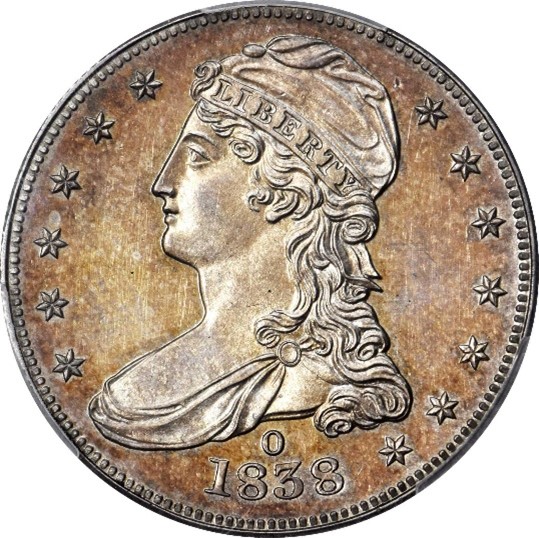
The 1838-O is the second rarest of all U.S. half dollars. While it is debatable as to whether the 1838-O is a Proof-only date, I hypothesize that there never were business strike 1838-O halves; all minted are either Proofs or Specimen Strikings that are close to being Proofs. Fewer than eleven 1838-O half dollars survive and thousands of people collect Capped Bust halves. Even so, the extreme rarity of Philadelphia Mint Proofs and the fact that the Pittman-Pogue Proof 1838 was auctioned for $336,000 in August 2018 suggest that it is logical to consider Proof 1838-O halves for type sets.
In November 2019, Stack’s-Bowers auctioned a CAC approved Proof-63 1838-O half for $504,000. In my view, it made far more sense to pay $504,000 for this coin than $336,000 for the already mentioned Pittman-Pogue, PCGS certified Proof-66+ 1838 Philadelphia Mint half. There are many 1838 Philadelphia Mint business strike halves around. Regardless of how each is designated or certified, the 1838 New Orleans Mint issue is a famous Great Rarity.
The 1839-O halves that are sometimes certified as Proofs are a different matter, which should be discussed separately. CAC has approved one such coin, a Proof-64 1839-O half that I have never seen. A few 1838-O halves are more convincing as Proofs than any 1839-O half that I have examined.
In theory, 1836-37 and 1838-39 Gobrecht Reeded Edge halves could be referred to as two different design types, as the representation of the denomination on the reverse was changed from “50 CENTS” to “HALF DOL.” As this difference relates only to a small portion of the reverse, one Proof Gobrecht (Reeded Edge) half is sufficient for a type set, in my view. Nevertheless, it may be fun to acquire one of each, especially since Proof 1836 Gobrecht Reeded Edge halves appear so different from Proof 1838 Gobrecht Reeded halves, in terms of striking characteristics.

Show off Your Collection in the CAC Registry!
Have CAC coins of your own? If so, check out the CAC Registry–the free online platform to track your coin inventory, showcase your coins by building public sets, and compete with like-minded collectors!
Type #4 – Reich Capped Bust, ‘Lettered Edge’ (1807-36)
Some pre-1826 halves that are represented as Proofs or non-Proof Special Strikings are controversial. Some others are markedly different from later half dollars that are definitely Proofs. Moreover, regardless of their respective physical characteristics, pre-1826 halves that are certified as Proofs tend to be very expensive. For a type set of Proof half dollars, I recommend seeking a Proof, Reich Capped Bust ‘Lettered Edge’ half that dates from 1826 to 1835.
On April 27, 2017, Heritage auctioned CAC approved, NGC certified Proof-63 1829 half for $39,950. On January 10, 2013, Heritage auctioned a CAC approved, PCGS certified Proof-62-Cameo 1830 half dollar for $35,250.
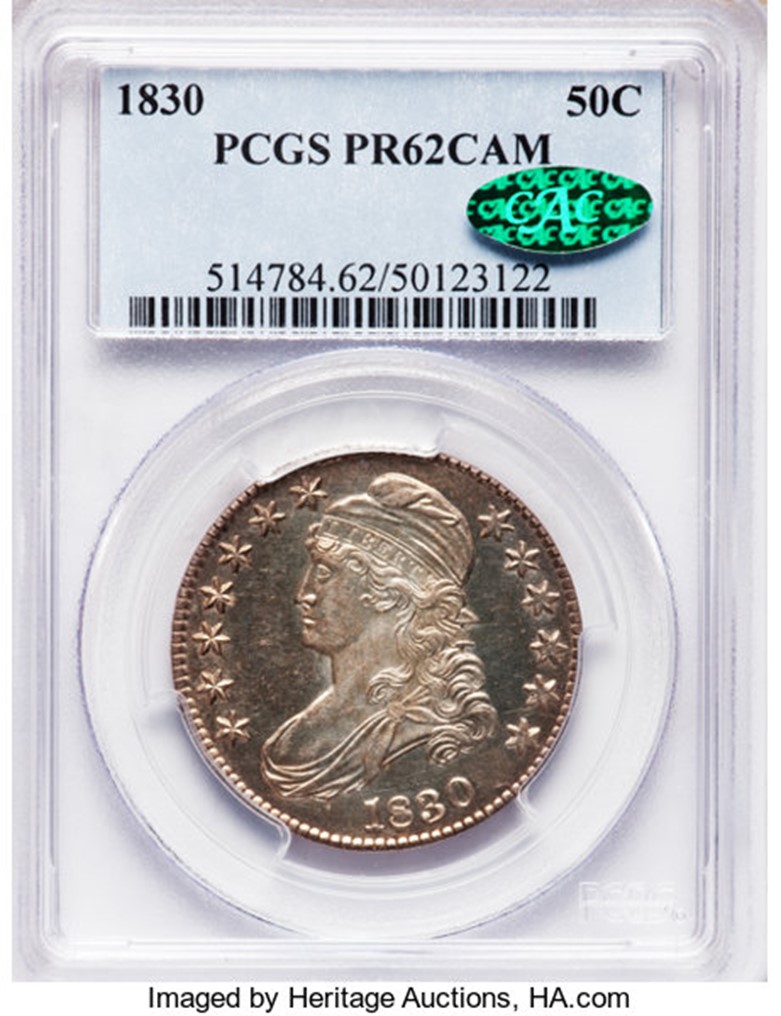
As of October 31, 2021, the CPG-CAC retail price estimates for Proof-64, Reich Capped Bust halves (1807-36), are in the range of $66,000 to $90,000. A CAC approved Proof-65 1829 is estimated to have a retail value of $114,000, and a CAC approved Proof-65 1830 is estimated to be worth $109,000. The four CAC approved Proof-66 coins of this type are worth considerably more than CAC approved Proof-64 or -65 Reich Capped Bust halves.
On January 10, 2013, Heritage auctioned a CAC approved Proof-66 1827 half for $158,625. It was earlier in the famous collection of John J. Pittman. On August 16, 2018, Heritage auctioned this same Proof 1827 half for $192,000.
For a type set of Proof halves, I suggest that a collector select a Reich Capped Bust (Lettered Edge) coin that has exceptional Proof characteristics, rather than focus on the numerical grade. Some of those certified as Proofs barely qualify as Proofs, while others are characterized by incredible mirrors, sharp details and considerable squaring of design elements.
The subject of pre-1826 half dollars that are certified or otherwise represented as Proofs or as non-Proof Special Strikings is complicated. I recommend that a type set of Proof half dollars be limited to coins that were minted after 1825.
For decades, I have been viewing early U.S. coins in major auctions and at major coin conventions. I have never seen a Proof Draped Bust or Flowing Hair half dollar. I have seen one 1796 half dollar that might be a Special Striking, though is certainly not a Proof. Overall, a type set of Proof U.S. half dollars would be a challenge, though is a realistic objective. While I suggest hiring a consultant, a collector who is serious about studying the respective coins and learning could complete a very impressive set without assistance, especially if he or she focuses on CAC approved coins.
Images are copyrighted by Heritage Auctions (HA.com), Stack’s Bowers Galleries (Costa Mesa, CA) or Ira & Larry Goldberg Coins & Collectibles (Los Angeles).
Copyright © 2021 Greg Reynolds
About the Author
Greg is a professional numismatist and researcher, having written more than 775 articles published in ten different publications relating to coins, patterns, and medals. He has won awards for analyses, interpretation of rarity, historical research, and critiques. In 2002 and again in 2023, Reynolds was the sole winner of the Numismatic Literary Guild (NLG) award for “Best All-Around Portfolio”.
Greg has carefully examined thousands of truly rare and conditionally rare classic U.S. coins, including a majority of the most famous rarities. He is also an expert in British coins. He is available for private consultations.
Email: Insightful10@gmail.com
